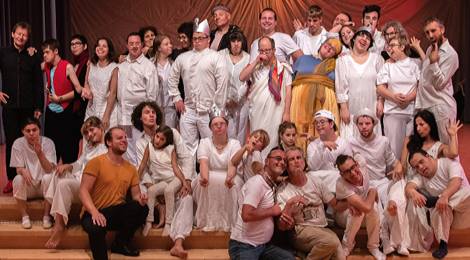Last autumn, another remarkable visit to Germany, specifically, to EINS UND ALLES, the amazing inclusive community near Stuttgart, with whom we have mounted new shows every October for the last couple of years.
Every year, new challenges and rewards. This year, our friends decided to anticipate the premiere of our new show, “Unfolding,” at the regional capital, in Waiblingen. We weren’t at all sure that our wards would be up to the stress of an interruption of the already-too-short rehearsal process, to perform on an unfamiliar stage. This would be a challenge in the best of cases, working with what I call “normopath” professionals; what about our special needs actors?
I was concerned about our artists adapting to the space, so we planned on seeing it as soon as possible.
And when we did, my heart sank. The “performance space” set aside for us was a dark asymmetrical well, half foyer and half something not at all clear, steeply banked on two sides, with a low-hanging cement bridge over most of the stage, which our taller actors were unable to pass under without hitting their heads, lit by harsh Led lights and carpeted with that grey synthetic carpet, abrasive to human flesh, which is the bane of dancers the world over.
The only stage decoration was a petrified ichthyosoraus which someone, for some reason, had mounted on the back wall. When I saw it, my first thought was that it was the last director who had tried to direct a show in this space.
Don’t get me wrong. As a foyer it was fine, even innovative, in its way. But as a theatrical space it was a disaster. There was’t even room for all 30 actors to make a circle, without losing some of them down the stairs which parted unexpectedly just off stage right. (Stage left finished in a blank wall, so there was no danger of falling in exiting that way, although a broken nose was a real possibility).
 So we smiled and said, “Fine.” Our German partners had made it clear that, if the right people saw the show here at the regional seat, we might get some institutional support. We are prepared to do anything we can to disseminate the work, so we accepted.
So we smiled and said, “Fine.” Our German partners had made it clear that, if the right people saw the show here at the regional seat, we might get some institutional support. We are prepared to do anything we can to disseminate the work, so we accepted.
The night of the performance, we had a full house: about 80 people were packed into the well-like audience space. The actors made a circle and we started warming up: singing, rhythmical clapping, mirror games… from the start it was clear that the audience was listening. Even with my back to them, I could feel their interest.
And the show began, the first, tentative steps into the light. It’s always exciting, the first time you try a show in front of the audience, there are always surprises. But with differently abled actors, the surprises are generally bigger, more generous, more joyful.
At a certain point, our philosopher decided to climb into the second row, sit down next to the boss, and enjoy the show (which would not proceed until he decided to go back onstage). In the meantime, one of our autistic courtiers began bowing, solemnly and elegantly, to everyone in sight. He was enjoying this way of meeting people, and he wasn’t going to stop for mere dramaturgical reasons.
 These are the happy incidents of making theater with the differently abled: it is inclusive in the most generous sense. That evening, something rare and wonderful happened: the distinctions between audience and stage were joyfully blurred. By the end of the play, the audience was singing even louder than we were.
These are the happy incidents of making theater with the differently abled: it is inclusive in the most generous sense. That evening, something rare and wonderful happened: the distinctions between audience and stage were joyfully blurred. By the end of the play, the audience was singing even louder than we were.
My fears of tiring our actors were completely misplaced. Better than any professionals, in this unlikely place, they wrapped their arms around the audience and took them to a place where the anarchic laughter of the gods resounds, joyful and deep, and brings good fortune to those lucky enough to witness it.
Now, at year’s end, it is a joy and a comfort to me to listen to the echo of that laughter.



Recent Comments